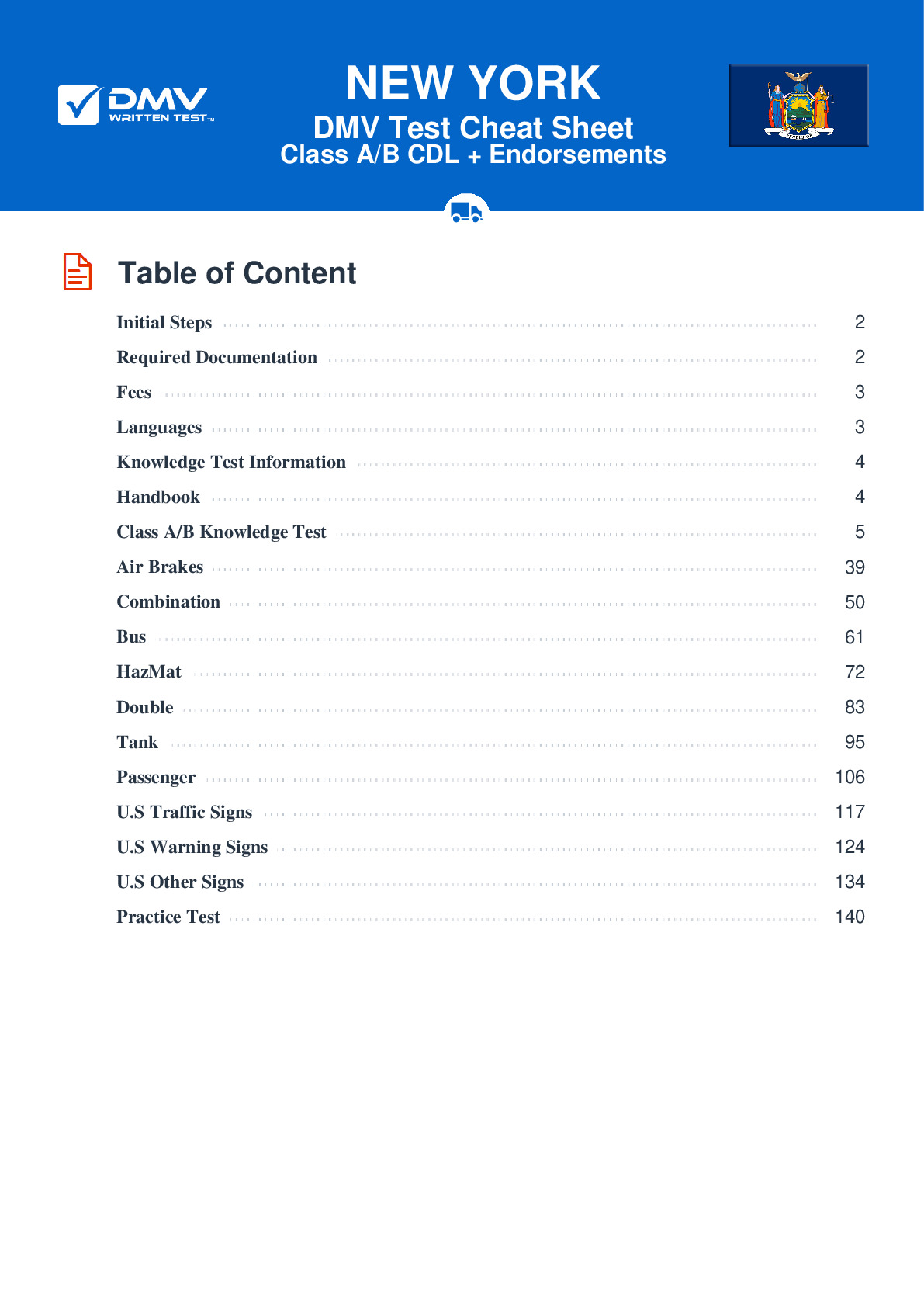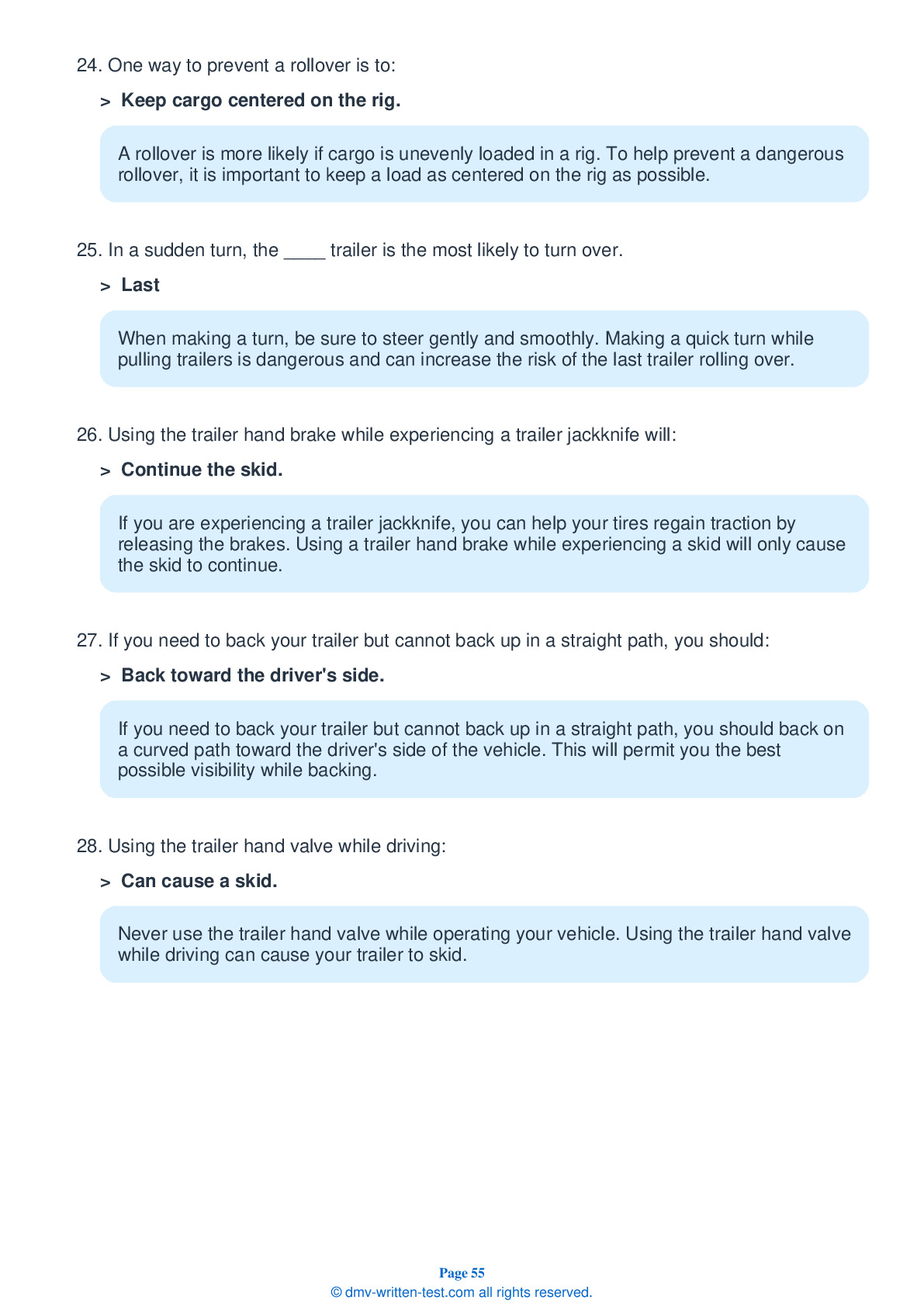Knowledge Test Class A
This license is required for driving any legal combination of vehicles, with a gross combination weight rating of 26,001 pounds or more, provided the GVWR of a trailer exceeds 10,000 pounds. To receive this license, applicants must pass a 70-question test. Test questions come from the New York State Commercial Motor Vehicle Drivers Handbook. Each question has four answer choices. To pass, applicants must answer 56 questions correctly. Questions come from chapters covering: Introduction, Driving Safely, Transporting Cargo Safely, Air Brakes (if applicable), Combination Vehicles, Pre-Trip Vehicle Inspection Test, Basic Vehicle Control Skills Test and On-Road Driving. Endorsements that may be used with a Class A CDL are: Hazardous materials, Tank, Passenger, Doubles/Triples, HazMat, Tank, Air Brakes and School bus.
29. When it is difficult for others to see your vehicle, such as at dawn or dusk, you can help other drivers by:
At times when visibility is low, you should turn your headlights on to the low beam setting. If you are having a difficult time seeing others, they are probably having a difficult time seeing you.
30. During the pre-trip vehicle inspection test:
During the external inspection portion of the pre-trip vehicle inspection test, you must verify that the steering box is securely mounted and not leaking.
31. How could you reduce your stress while driving?
Being under stress can lead to aggressive driving, which is dangerous. Playing calming music can help you become more relaxed if you are feeling stressed while driving.
32. When a vehicle is started, warning lights and buzzers:
After an engine is started, the warning lights and buzzers for oil, coolant, charging circuits, and the Anti-Lock Braking System (ABS) should go out right away.
33. In a dual air brake system, a leak in one system:
A dual air brake system is made up of two separate air brake systems. If there is an air leak in one system, it may not affect the other.
34. How can you avoid becoming drowsy on a trip?
Strategies to reduce the risk of fatigue while driving include getting seven to eight hours of sleep beforehand; scheduling trips for the hours during which you are normally awake; planning to take breaks during the trip; and exercising regularly.
35. Which of the following is not acceptable emergency equipment?
During the vehicle inspection test, you will need to show emergency equipment, including spare electrical fuses; three red reflective triangles, six fuses, or three liquid burning flares; and a properly charged and rated fire extinguisher.
Frequently Asked Questions
1. Be at least 18 years old to drive within the state of New York or 21 years old to drive across state lines.
2. Hold a valid New York State driver's license.
3. Provide proof of your identity and residency in New York State.
4. Pass a medical examination and obtain a valid medical examiner's certificate.
5. Pass a written knowledge test covering the rules and regulations for commercial drivers.
6. Obtain a learner permit by passing the written test and paying the required fee.
7. Complete a state-approved commercial driver training program or gain equivalent experience driving commercial vehicles.
8. Pass a road skills test in the type of vehicle for which you are seeking a license.
It's important to note that there may be additional requirements depending on your specific situation, such as additional endorsements or restrictions on your license. It's recommended to check with your local DMV office for more information on the requirements for obtaining a Class A CDL license in New York.
If you plan to drive within the state of New York, you must be at least 18 years old to obtain a Class A CDL license.
If you plan to drive a commercial vehicle across state lines or transport hazardous materials, you must be at least 21 years old to obtain a Class A CDL license.
It's important to note that some employers may have their own age requirements for hiring commercial drivers, so it's always a good idea to check with the employer before pursuing a CDL license.
1. T - Double/Triple Trailers Endorsement: Required for drivers who will be towing two or three trailers behind a single vehicle.
2. P - Passenger Endorsement: Required for drivers who will be transporting 16 or more passengers in a commercial vehicle.
3. N - Tank Vehicles Endorsement: Required for drivers who will be transporting liquids or gases in tanks that have a capacity of 1,000 gallons or more.
4. H - Hazardous Materials Endorsement: Required for drivers who will be carrying hazardous materials that require placards according to Federal Hazardous Materials Regulations.
It's important to note that endorsements require additional knowledge and skills tests and may have additional fees associated with them. It's recommended to check with your local DMV office for more information on which endorsements you may need for your specific situation.
1. Pre-trip Inspection: This portion of the test requires you to inspect your vehicle to ensure that it is safe to operate. You will be asked to identify and explain the function of various parts of the vehicle, including the engine compartment, cab interior, and outside of the vehicle.
2. Basic Vehicle Control Skills Test: This portion of the test requires you to demonstrate your ability to control your vehicle in a variety of situations. You will be tested on your ability to perform basic maneuvers such as backing up in a straight line, backing around a corner, and parallel parking.
3. On-road Driving Test: During this portion of the test, you will be evaluated on your ability to safely operate your vehicle in traffic. You will be asked to drive on public roads and highways while demonstrating your ability to maintain control of the vehicle, follow traffic laws and signals, and safely interact with other drivers.
It's important to note that each state may have slightly different requirements or procedures for the Class A CDL skills test. Therefore, it's recommended that you check with your local DMV office for specific information about the skills test in your area.
1. Air Brake Restriction: If you take your skills test in a vehicle without air brakes, you will be restricted to driving only those vehicles without air brakes.
2. Automatic Transmission Restriction: If you take your skills test in a vehicle with an automatic transmission, you will be restricted to driving only those vehicles with automatic transmissions.
3. Intrastate Only Restriction: If you do not meet the federal medical requirements for interstate driving, you may be restricted to driving only within your state or within a designated radius from your home base.
4. Passenger Vehicle Restriction: If you do not pass the passenger endorsement test, you will be restricted from operating a commercial vehicle that is designed to transport 16 or more passengers.
5. Hazardous Materials Restriction: If you do not pass the hazardous materials endorsement test, you will be restricted from transporting hazardous materials that require placards according to Federal Hazardous Materials Regulations.
It's important to note that each state may have slightly different restrictions or limitations for Class A CDL drivers. Therefore, it's recommended that you check with your local DMV office for specific information about restrictions or limitations in your area.
For example, in New York State, the Class A CDL written test is available in several languages other than English, including Spanish, Chinese, French Creole, Italian, Korean, Polish, and Russian. However, in some states, the written test may only be available in English.
It's important to check with your local DMV office to find out if the written test is available in a language other than English and what languages are supported. If the test is not available in your preferred language, you may need to bring an interpreter with you to help you take the test. However, it's important to note that not all DMVs allow interpreters during the written test.
Examples of accommodations that may be provided include extra time for the test, a reader or sign language interpreter, a private testing area, or a special testing device.
To request accommodations, you will need to contact your local DMV office and provide documentation of your disability. The documentation should describe how your disability affects your ability to take the test and what specific accommodations you need.
It's important to note that you should submit your request for accommodations as early as possible, as it may take some time for the DMV to process your request and make arrangements for the accommodations.
In New York State, for example, you can retake the Class A CDL written test as many times as needed, but you will need to wait at least one day before taking it again. There is also a fee for each attempt at the test.
It's important to use your failed test as a learning opportunity and study more before taking it again. You can review the DMV's driver's manual and take practice tests to prepare for the next attempt. It's also a good idea to identify any areas where you struggled on the test and focus on those areas when studying for the retake.




